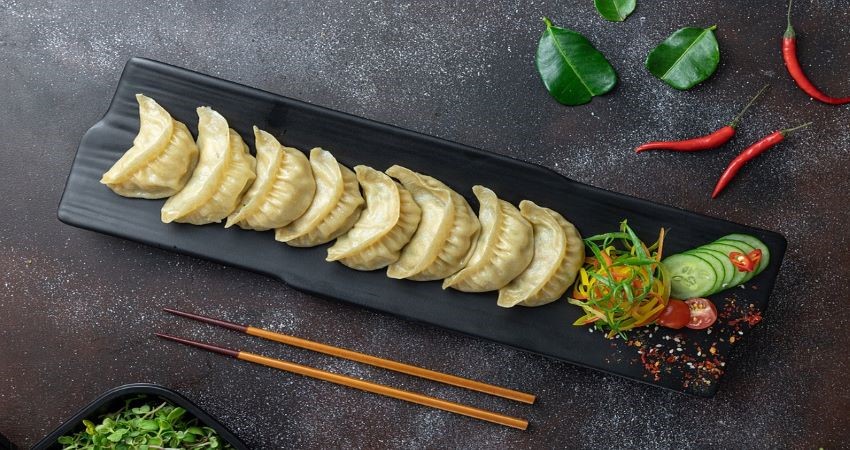I am sure most of us would have tasted these: Dumplings, Momos & Dimsums. Have you ever wondered if all three are the same or if is there any difference between them? It could be the cultural origins, ingredients, or cooking methods that make one different from the other. But everyone who has had it will agree on one point, the striking similarity of little balls of flour filled with some form of filling in all three. These delicious dumplings are ideal to cheer you up on any gloomy day. Read on to know more about these not-so-heavy, healthy bites which you can’t stop by eating just one!
A popular snack in many parts of the world has a history as rich as the flavors inside them. It is believed that dumplings were invented by Zhang Zhongjing, a Chinese medicine practitioner. Archeologists have found evidence of dumplings being eaten in China during the Tang dynasty and in Switzerland in 3,600 B.C. The first use of the term “dumpling” appeared in a Roman cookery manuscript called Apicius which was written sometime around A.D. 400. Dumplings have been around for a long time, but it wasn’t until the 17th century that it finally got its name. Dumplings, a part of popular Asian cuisine, are made with three simple ingredients, flour, water, and salt. From steamed to boiled, pan-fried to deep-fried, there are different types of dumplings around the world. Depending on their geographical location, dumplings vary in shape and size. The inside is generally filled with vegetables, pork, chicken, fish, or at times no filling at all. They are called by different names: gyoza in Japan, mandu in Korea, and gujiyas in India. Even our very own Indian Samosas fall under the fried dumpling category. Today these dumplings have become a favorite street food and a crowd-pleaser at parties and family gatherings.
The history of momo is not very unclear as there is no exact proof of where it came from or who invented it. Contrary to the popular belief, Momos are not Chinese but are Tibetan/Nepalese special food. The word ‘momo’ is derived from the Tibetan word ‘mog mog’ which means ‘food related to flour’. The history of momo can be traced back to as early as the fourteenth century. Initially a Newari food, Momos was introduced to Tibet, China, and Japan by a Nepalese princess who married a Tibetan king. Momos are so popular in Nepal that it is eaten as a staple food and are available in every restaurant and hotel.
Traditionally Momos are made with ingredients like lamb or yak meat, potatoes, and cheese. But after arriving in India the fillings started being made with vegetables too to suit the Hindu diaspora. Unlike dumplings, momos always have fillings, they never come without any filling. Momos are less of a fine-dining experience and more of being enjoyed in a casual setting. Just like the dumplings, they are also made with wheat flour, stuffed with some filling and steamed. These bite-sized momos are often served with a spicy chili sauce to complete the tasty snack.
Dim sum is a Chinese snack originating from the Song dynasty between 960-1279. The word Dim Sum means ‘touch the heart’. Ancient Silk Road travelers and traders through China would take breaks to rest before continuing their journey. In response to the increasing amount of people passing through, teahouses opened up on either side along the roadside. These teahouse owners began offering bite-sized snacks as an accompaniment and thus Dim sum was born. What started as a small snacking secession has now evolved into an art of eating various small dishes while sipping some hot Chinese tea.
Dim sums are often mistaken for dumplings because of their presentation. However, in dim sum, the outer covering is generally semi-transparent or fully transparent. Dim sums are never served alone, they are always served with breakfast or beverages like tea. This is the reason why eating dim sum can also be regarded as ‘drinking tea’ in China. This Cantonese style of street food comes in both sweet and savory variants. Unlike momos or dumplings, the floor of the dough can be from rice, wheat or even potato starch. The outer layer of a dim sum is so transparent that it shows off the finely diced or chopped filling, making it visually appealing too. Dim Sum comes more under fine dining rather than being a regular street food. There are more than a thousand types of dim sums ranging in flavors, textures, and fillings which can be used as a regular dish or for special occasions, or even as offerings for deities.
No matter how similar it all seems one cannot deny the fact that they have become tasty staples in many countries. So don’t think much, go ahead and stuff your mouth with these one-of-a-kind delicacies!





